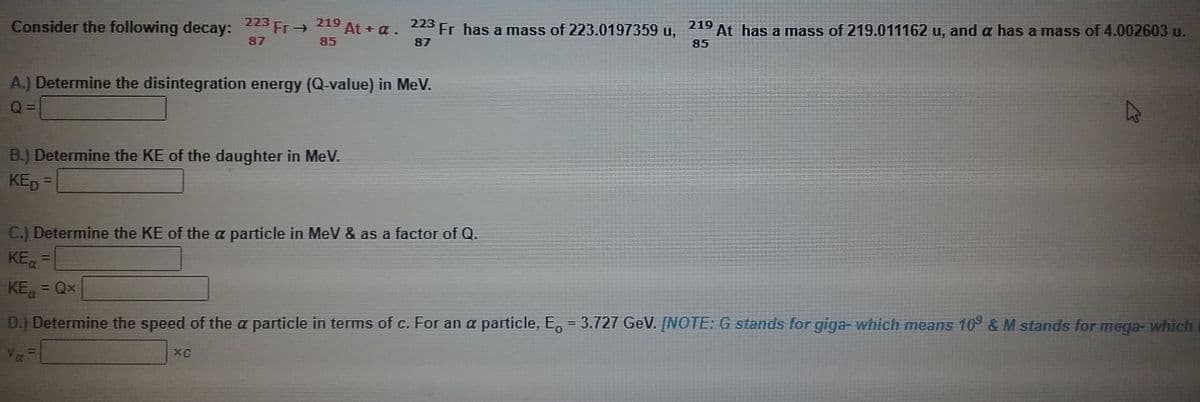Consider the following decay: 223 Fr - 219 At + a. 223 Fr has a mass of 223.0197359 u, 219 At has a mass of 219.011162 u, and a has a mass of 4.002603 u. 87 85 87 85 A.) Determine the disintegration energy (Q-value) in MeV. Q = B.) Determine the KE of the daughter in MeV. KE, = C.) Determine the KE of the a particle in MeV & as a factor of Q. KE, = KE = Qx D.) Determine the speed of the a particle in terms of c. For an a particle, E, = 3.727 GeV. [NOTE: G stands for giga- which means 109 & M stands for mega- which
Consider the following decay: 223 Fr - 219 At + a. 223 Fr has a mass of 223.0197359 u, 219 At has a mass of 219.011162 u, and a has a mass of 4.002603 u. 87 85 87 85 A.) Determine the disintegration energy (Q-value) in MeV. Q = B.) Determine the KE of the daughter in MeV. KE, = C.) Determine the KE of the a particle in MeV & as a factor of Q. KE, = KE = Qx D.) Determine the speed of the a particle in terms of c. For an a particle, E, = 3.727 GeV. [NOTE: G stands for giga- which means 109 & M stands for mega- which
Chemistry: Principles and Practice
3rd Edition
ISBN:9780534420123
Author:Daniel L. Reger, Scott R. Goode, David W. Ball, Edward Mercer
Publisher:Daniel L. Reger, Scott R. Goode, David W. Ball, Edward Mercer
Chapter21: Nuclear Chemistry
Section: Chapter Questions
Problem 21.40QE
Related questions
Question
100%
Please help me answer the following.

Transcribed Image Text:219 At + a.
223
Fr has a mass of 223.0197359 u,
87
21º At has a mass of 219.011162 u, and a has a mass of 4.002603 u.
223 Fr→
Consider the following decay:
87
85
85
A.) Determine the disintegration energy (Q-value) in MeV.
B.) Determine the KE of the daughter in MeV.
KED =
%3D
C.) Determine the KE of the a particle in MeV & as a factor of Q.
KE, =
KE
%3D
%3D
Qx
D.) Determine the speed of the a particle in terms of c. For an a particle, E, = 3.727 GeV. [NOTE: G stands for giga- which means 109 & M stands for mega- which
Expert Solution
This question has been solved!
Explore an expertly crafted, step-by-step solution for a thorough understanding of key concepts.
Step by step
Solved in 2 steps with 2 images

Knowledge Booster
Learn more about
Need a deep-dive on the concept behind this application? Look no further. Learn more about this topic, chemistry and related others by exploring similar questions and additional content below.Recommended textbooks for you

Chemistry: Principles and Practice
Chemistry
ISBN:
9780534420123
Author:
Daniel L. Reger, Scott R. Goode, David W. Ball, Edward Mercer
Publisher:
Cengage Learning

Chemistry: Principles and Reactions
Chemistry
ISBN:
9781305079373
Author:
William L. Masterton, Cecile N. Hurley
Publisher:
Cengage Learning

Chemistry by OpenStax (2015-05-04)
Chemistry
ISBN:
9781938168390
Author:
Klaus Theopold, Richard H Langley, Paul Flowers, William R. Robinson, Mark Blaser
Publisher:
OpenStax

Chemistry: Principles and Practice
Chemistry
ISBN:
9780534420123
Author:
Daniel L. Reger, Scott R. Goode, David W. Ball, Edward Mercer
Publisher:
Cengage Learning

Chemistry: Principles and Reactions
Chemistry
ISBN:
9781305079373
Author:
William L. Masterton, Cecile N. Hurley
Publisher:
Cengage Learning

Chemistry by OpenStax (2015-05-04)
Chemistry
ISBN:
9781938168390
Author:
Klaus Theopold, Richard H Langley, Paul Flowers, William R. Robinson, Mark Blaser
Publisher:
OpenStax

Principles of Instrumental Analysis
Chemistry
ISBN:
9781305577213
Author:
Douglas A. Skoog, F. James Holler, Stanley R. Crouch
Publisher:
Cengage Learning

Chemistry: The Molecular Science
Chemistry
ISBN:
9781285199047
Author:
John W. Moore, Conrad L. Stanitski
Publisher:
Cengage Learning

Chemistry: An Atoms First Approach
Chemistry
ISBN:
9781305079243
Author:
Steven S. Zumdahl, Susan A. Zumdahl
Publisher:
Cengage Learning